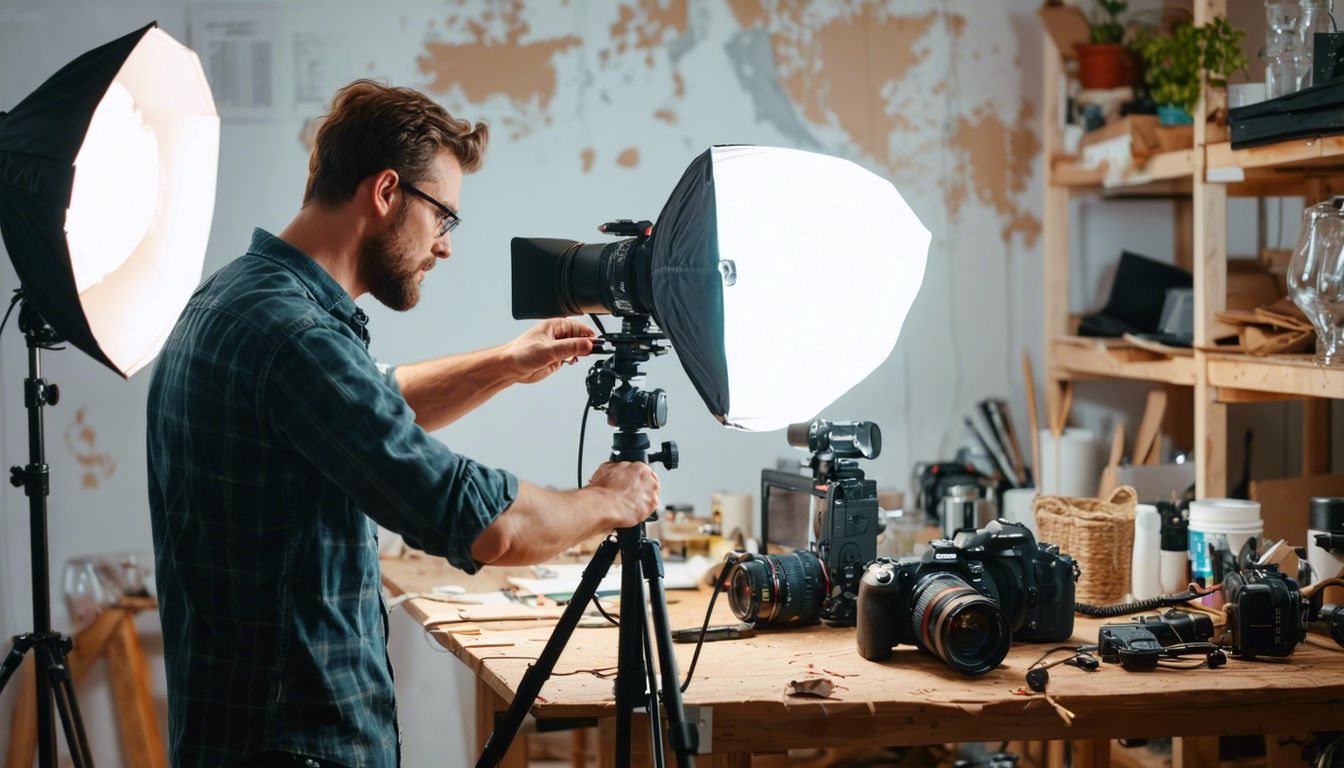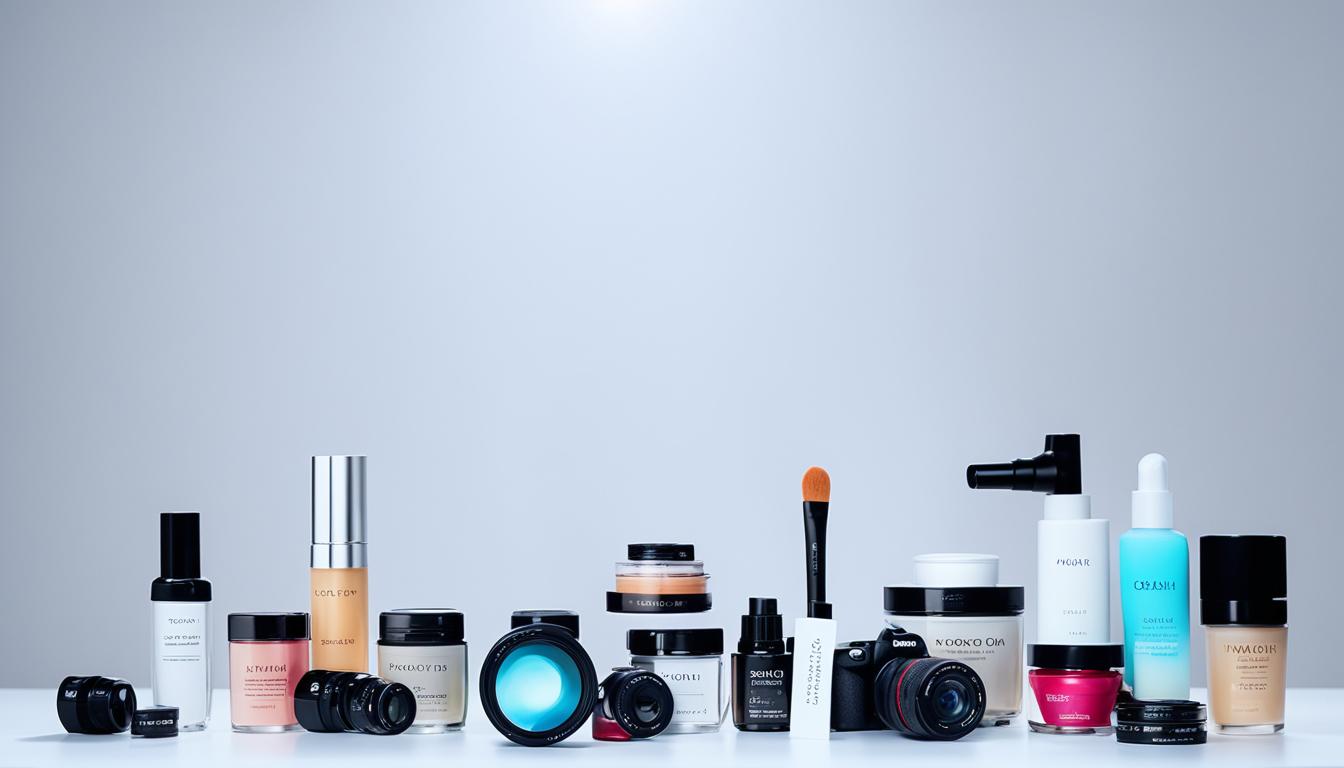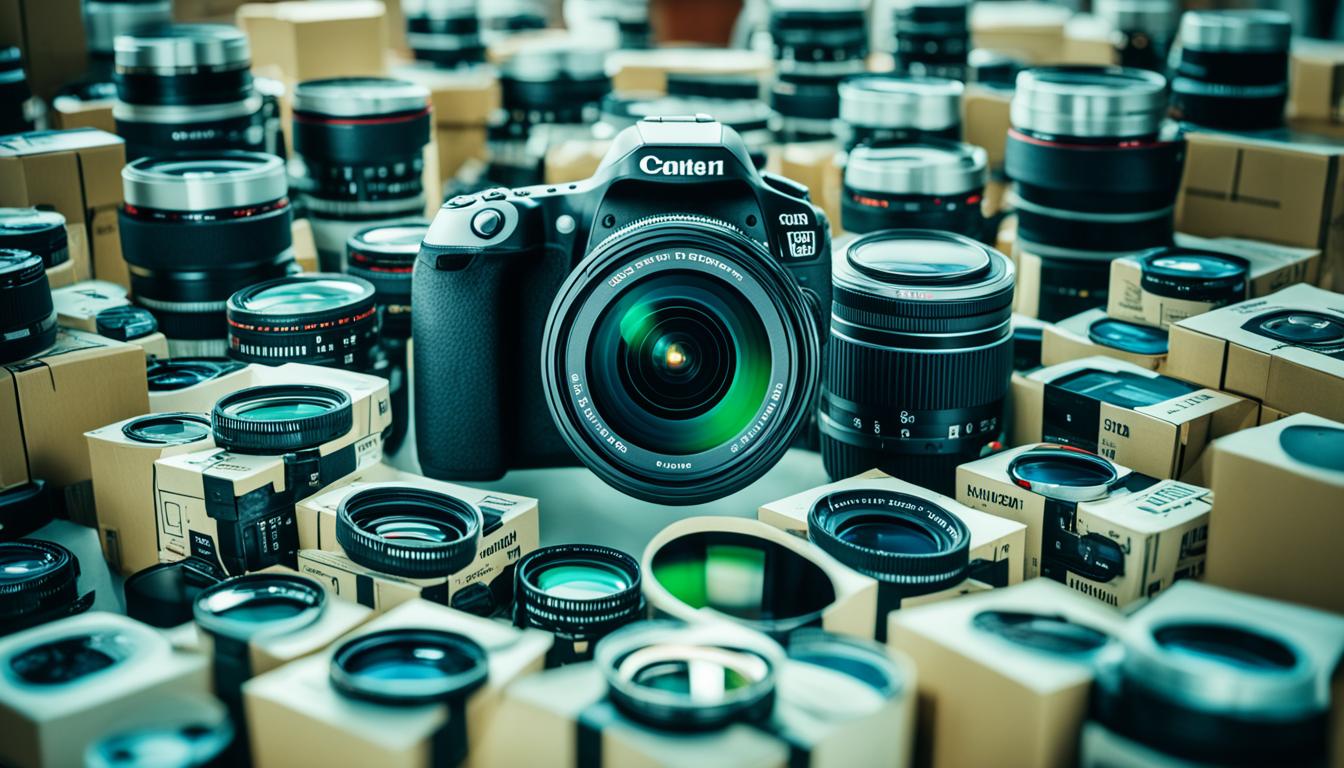In today’s increasingly online world, having a strong online presence is crucial for brands, even those with physical stores. Product photography plays a vital role in showcasing your brand’s credibility and driving sales. By working with experienced photographers, you can create specific, narrative-driven images that provide information, build trust, and create desire for your products. This article will explore how to use creative product photography to elevate your e-commerce store and brand.
Key Takeaways:
- Creative product photography is essential for showcasing your brand’s credibility and driving sales.
- Working with experienced photographers can help you create narrative-driven images that build trust and create desire for your products.
- Investing in creative product photography is an investment in your brand’s success and online presence.
- By utilizing innovative product photoshoot ideas and artistic product presentation, you can captivate your audience and differentiate your brand.
- Visual storytelling in product photography can create an emotional connection with your target audience and increase engagement.
The Power of Quality Photography in Driving Sales.
High-quality photography is a game-changer in the e-commerce industry. Attracting potential customers, it conveys professionalism and trustworthiness. When it comes to online shopping, visuals are essential in building credibility and making a lasting impression. Quality images have numerous benefits, from showcasing your dedication to excellence to gaining a competitive advantage in the market.
Investing in professional product photography pays off in the long run. It helps create a positive brand image, establish trust with shoppers, and ultimately drives sales. With attention to detail and expertise, quality photography highlights the unique features of your products, making them more desirable to customers.
When customers come across visually appealing, well-crafted product photos, they perceive your brand as professional and trustworthy. This, in turn, significantly increases the likelihood of making a purchase.
Building Professionalism and Trustworthiness
Quality photography is crucial for e-commerce businesses looking to distinguish themselves from their competitors. By investing in professional product photography, you demonstrate your commitment to delivering exceptional products and services.
“Professionalism is not just about an image; it’s also about the value you deliver to your customers through high-quality products and experiences.”
When customers can see the details, textures, and colors of your products accurately represented in images, they develop a sense of trust in your brand. Through quality photography, you can effectively communicate the craftsmanship and excellence of your offerings, giving customers the confidence to make a purchase.
Gaining a Competitive Advantage
In a competitive e-commerce landscape, having high-quality product images gives you an edge over your rivals. Capturing the attention of potential customers is the first step towards securing a sale. By investing in quality photography, you can stand out from the competition and leave a lasting impression in the minds of consumers.
When faced with a choice between a store with generic and unprofessional product photos and one with stunning, high-quality images, customers are more likely to choose the latter. Quality photography not only attracts customers but also encourages them to engage with your brand, browse your products, and convert into buyers.
For e-commerce businesses, the power of quality photography in driving sales cannot be underestimated. Professional and visually appealing images convey professionalism, build trust, and ultimately give your brand a competitive advantage. It’s an investment that guarantees a positive impact on your bottom line and solidifies your position in the market.
Elevating Products Through Still Life Photography.
Still life photography is a captivating and unconventional approach to showcasing products, breaking away from the traditional white background shots. One photographer known for his exceptional talent in this style is Adam Barclay. Through his masterful play with light and shadow, Adam creates visually stunning images that evoke a sense of sophistication and luxury.
Instead of solely focusing on the product itself, Adam Barclay expertly crafts a connection between the product and its surroundings. By skillfully incorporating props and carefully curating the environment, he brings the product to life in a way that resonates with viewers.
For luxury brands in particular, still life photography offers a unique opportunity to elevate their products and create a memorable visual experience. By capturing the essence of luxury and highlighting the intricate details through artistic compositions, this style of photography can truly capture the attention of discerning consumers.
Let’s take a closer look at some of Adam Barclay’s mesmerizing still life photography:
The Elegance of Light and Shadow
Adam Barclay’s mastery lies in his ability to use light and shadow to create a captivating interplay of contrast in his still life images. By skillfully manipulating these elements, he brings out the beauty and depth of each product, highlighting its unique features and qualities.
“I believe that the interplay of light and shadow adds a touch of mystery and intrigue to still life photography. It creates a sense of depth and evokes a feeling of luxury,” says Adam Barclay.
Creating a Narrative Through Props
Props play a crucial role in Adam Barclay’s still life photography, as they help create a narrative around the product. Each prop is carefully chosen to complement the product, adding layers of meaning and visual interest to the composition.
Whether it’s a vintage book alongside a pair of exquisite cufflinks or a delicate rose placed next to a luxury perfume bottle, the props play a vital role in telling a story and invoking emotion.
Appealing to the Luxury Industry
Adam Barclay’s still life photography has garnered significant attention from the luxury industry. His ability to capture the essence of luxury and translate it into captivating visuals has made him a sought-after photographer for high-end brands.
With his unique approach, Adam Barclay has successfully positioned himself at the forefront of luxury product photography, showcasing the artistry and craftsmanship behind each product.
Image:

Creative Product Photography: Telling Stories Through Images.
One way to make your product photography more engaging is by telling stories through images. Instead of simply displaying a basic product image, try incorporating the product into a lifestyle setting or showing it in use. This approach allows customers to visualize themselves using the product and creates an emotional connection. Additionally, showcasing products in different contexts can make your images more captivating and memorable.
By placing your product in a lifestyle setting, you give customers a glimpse into how the product fits into their everyday lives. For example, if you’re selling a camping tent, instead of a plain image of the tent, you could show a family enjoying a camping trip, using the tent as the focal point. This not only highlights the features of the product but also creates a relatable and aspirational image that speaks to your target audience.
Incorporating in-use photography can also help potential customers envision themselves using the product. Let’s say you’re selling a kitchen appliance. Instead of just showing the appliance on its own, consider showcasing it in action, with a close-up of someone using it to create a delicious meal. This type of image creates a sense of desirability and demonstrates the practicality of the product.
Furthermore, introducing lifestyle settings and in-use photography can evoke emotions and tell a story. You can create a narrative around your product, showing how it can enhance people’s lives or solve their problems. Whether it’s capturing the joy of a child playing with a toy or the satisfaction of achieving a fitness goal with the help of your product, storytelling through images adds depth and resonance to your brand.
By utilizing lifestyle settings and in-use photography, you can create visually compelling images that resonate with your target audience, leading to increased engagement and conversion rates. Remember to ensure that the style of the photography aligns with your brand identity and evokes the desired emotions. Consistency across your product images will help establish a cohesive visual presence that strengthens your brand image.
| Benefits of Telling Stories Through Images: |
|---|
| 1. Creates emotional connection with customers |
| 2. Makes products more relatable and aspirational |
| 3. Helps customers envision themselves using the product |
| 4. Evokes emotions and tells a compelling story |
| 5. Increases engagement and conversion rates |
The Importance of Lighting in Creative Product Photography.
When it comes to creative product photography, lighting plays a crucial role in capturing the perfect shot. The way you illuminate your products can create different moods and effects, ultimately enhancing the overall impact of your images. Experimenting with lighting setups allows you to bring out the best in your products while adding depth and visual interest to your photos.
One lighting setup that can be used is soft, diffused lighting. This type of lighting creates a cozy and inviting atmosphere, making your products appear warm and approachable. It is particularly effective for showcasing products in lifestyle settings or when you want to convey a sense of comfort and relaxation.
On the other hand, harsh, directional lighting can create a dramatic effect. This type of lighting is ideal for highlighting specific details or adding a sense of intensity to your product images. It can create bold shadows and strong contrasts, resulting in eye-catching photos that command attention.
Experimenting with Shadows, Reflections, and Patterns
In addition to experimenting with different types of lighting, you can also incorporate shadows, reflections, and interesting patterns into your product photography. Shadows can add depth and dimension to your images, creating a sense of realism and visual intrigue. Reflections can be used to showcase the product from different angles or highlight its reflective surfaces. Interesting patterns, such as light patterns created by using a grid or a gobo, can add a unique touch to your photos and make them stand out.
Remember, the goal is to experiment and find the lighting setup that best complements your products and aligns with your brand’s aesthetic. Don’t be afraid to think outside the box and try new techniques to create captivating and visually stunning product images.

I always strive to push the boundaries of lighting in my creative product photography. By experimenting with different lighting setups, I can capture the essence of a product and bring it to life. Lighting is not just about illumination; it has the power to evoke emotions and tell a story. It’s an essential tool in creating memorable and impactful images.
Adding Props and Accessories for Visual Appeal.
When it comes to creative product photography, props and accessories can be powerful tools to enhance visual appeal and create a more immersive experience for your audience. By incorporating carefully selected items that complement your product, you can elevate the overall aesthetic of your images and captivate potential customers.
Props and accessories serve multiple purposes in product photography. Firstly, they add context and help tell a story about the product. Whether it’s a beautifully arranged bouquet of flowers alongside a skincare product or a stylish scarf draped elegantly over a handbag, these elements can create a visual narrative that evokes emotions and resonates with your target audience.
Furthermore, props and accessories can provide a sense of scale and demonstrate how the product can be used or styled in real-life situations. For example, showcasing a camera lens with a tripod and other photography equipment can give customers a better understanding of its size and functionality. By featuring complementary items in your images, you can inspire customers to envision themselves using your products, ultimately increasing their desire to make a purchase.
However, it’s important to strike a balance between using props and keeping the focus on the main product. Props should complement the product rather than overpowering it. The goal is to enhance visual appeal and create a cohesive visual story, not to distract or confuse customers.
When selecting props and accessories, consider the following:
- Choose items that align with your brand’s aesthetic and values. This ensures consistency and reinforces your brand identity.
- Opt for props that are relevant to the product and its intended use. This helps customers visualize the product’s benefits and functionality.
- Experiment with different textures, colors, and materials to add depth and visual interest to your images.
Remember, props and accessories should enhance the overall visual appeal of your product photography and complement the product itself. By carefully selecting and incorporating these elements into your images, you can create engaging visuals that captivate your audience and drive sales.
Example of Prop Usage in Creative Product Photography
“The delicate necklace is beautifully showcased, draped over a vintage jewelry box, adorned with elegant lace and a single red rose. The props not only add a touch of romance but also highlight the necklace’s dainty features, making it even more irresistible to potential customers.”
| Product | Description | Prop | Visual Appeal |
|---|---|---|---|
|
A handcrafted ceramic mug |
A rustic wooden coaster |
The natural textures of the coaster complement the mug’s earthy aesthetic, creating a cozy and inviting atmosphere. |
Consistency in Creative Product Photography and Branding.
In the world of branding and product photography, consistency is a crucial element in creating a strong and recognizable brand identity. By choosing a specific style that aligns with your brand’s values and objectives and maintaining it across your product images, you can establish a cohesive and memorable visual presence.
Consistency in creative product photography goes beyond just using the same techniques or settings for your images. It involves creating a distinct and recognizable brand identity that resonates with your target audience. When customers see your product images, they should be able to immediately associate them with your brand.
The Benefits of Consistency
Consistency in product photography and branding offers numerous benefits to your business:
- Recognition: When customers see consistent visuals across your product images, it helps build familiarity and recognition. This familiarity creates a sense of trust and reliability, making customers more likely to engage with your brand and make a purchase.
- Coherence: Consistency in imagery helps convey your brand’s story and messaging coherently. It allows you to showcase your products in a way that aligns with your brand values, creating a unified brand experience for customers.
- Professionalism: A consistent visual identity in product photography portrays professionalism and attention to detail. It communicates that you are serious about your business and that you strive for quality in every aspect of your brand.
- Competitive Advantage: Consistent branding sets you apart from competitors. It helps you establish a unique visual identity that customers can easily recognize and remember, giving you a competitive edge in the market.
Implementing Consistency in Product Photography
To incorporate consistency into your product photography, consider the following strategies:
- Define Your Brand’s Visual Style: Identify the key elements that represent your brand’s identity and develop a visual style guide. This guide should outline the desired color palette, lighting techniques, composition, and any other visual elements that align with your brand.
- Stick to Your Style Guide: Once you have defined your brand’s visual style, ensure that it is consistently applied to all your product images. This includes maintaining the same lighting setup, composition techniques, and overall aesthetic.
- Create Consistent Product Presentations: Whether you choose to showcase your products in lifestyle settings, on a plain background, or in a specific context, maintain consistency throughout your product photography. This ensures that your products are always presented in a way that aligns with your brand’s visual style.
By implementing consistency in your creative product photography, you can establish a strong brand identity and create a lasting impression on your audience. Remember to stay true to your brand’s values, define your visual style, and apply it consistently to all your product images.
| Benefits of Consistency | Implementing Consistency in Product Photography |
|---|---|
| 1. Recognition | 1. Define Your Brand’s Visual Style |
| 2. Coherence | 2. Stick to Your Style Guide |
| 3. Professionalism | 3. Create Consistent Product Presentations |
| 4. Competitive Advantage |
Conclusion.
Creative product photography is a powerful tool for elevating your brand and driving sales. By incorporating storytelling, experimenting with lighting, adding props, and maintaining consistency, you can create engaging and impactful images that captivate your audience.
Investing in professional product photography is an investment in your brand’s success. High-quality images that showcase your products in the best possible light not only build trust with potential customers but also give your brand a competitive advantage in the e-commerce industry.
If you’re looking to transform your product experience and enhance your online presence, consider utilizing the expertise of professional photographers and stylists to create visually compelling images that tell a story and resonate with your target audience. With the right approach to creative product photography, you can take your brand to new heights and leave a lasting impression on your customers.
FAQ
Why is quality photography important for driving sales?
Quality photography conveys professionalism, builds trust with shoppers, and gives your brand a competitive advantage in the e-commerce industry.
What is still life photography and how can it elevate products?
Still life photography is a unique approach that uses light and shadow to create visually stunning images. By incorporating this style, you can create a connection between the product and its surroundings, capturing your audience’s attention and elevating your products.
How can storytelling through images enhance creative product photography?
By incorporating the product into lifestyle settings or showing it in use, storytelling creates an emotional connection and allows customers to visualize themselves using the product.
Why is lighting important in creative product photography?
Lighting plays a crucial role in setting the mood and overall impact of your product images. Experimenting with different lighting setups can enhance the visual appeal and create desired effects.
How can props and accessories enhance creative product photography?
By adding props and accessories, you can make your photos more visually appealing and showcase the product in different contexts. However, it is important to ensure that the main focus remains on the product.
Why is consistency important in creative product photography and branding?
Consistency in product photography helps establish a strong visual presence and reinforces your brand’s messaging. It creates a unified brand experience for customers, making your brand more recognizable.
How can creative product photography elevate my brand?
Creative product photography, through storytelling, lighting techniques, props, and consistency, allows you to create engaging and captivating images that resonate with your audience, ultimately driving sales and enhancing your brand’s online presence.
How Can Creative Product Photography Help Protect Copyrights and Trademarks?
Creative product photography can play a crucial role in protecting product photography copyrights and trademarks. By showcasing unique angles, lighting, and composition, photographers can create distinctive images that help to establish and protect the intellectual property rights of brands and businesses.




